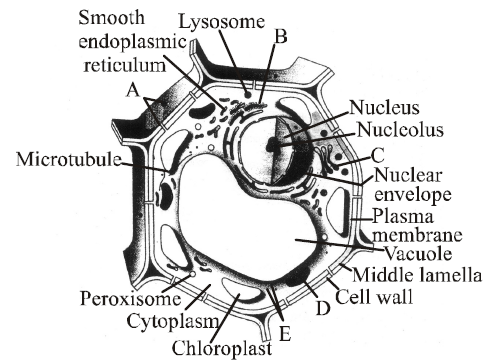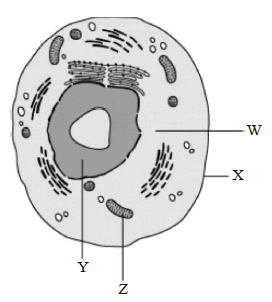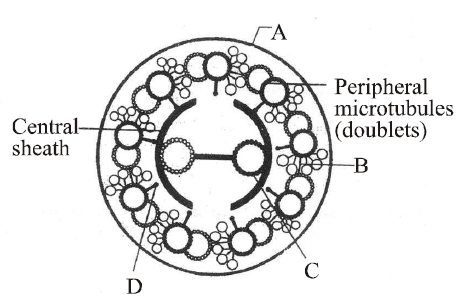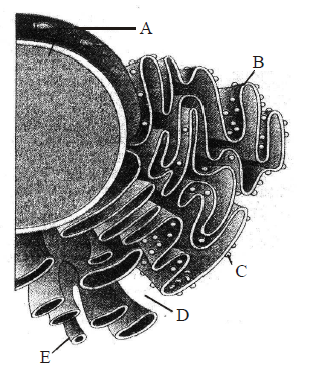The membrane of the erythrocytes has approximately ___% of proteins and ___% lipids.
42, 50
52, 40
50, 50
60, 40
Correct Answer :
B. 52, 40
The ratio of protein and lipids varies considerably in different cell types. The membrane of the erythrocytes has approximately 52% of proteins and 40% lipids.
Related Questions
The given diagram shows the sectional view of a mitochondrion.

Identify the parts labelled as A, B, C, D & E
A - Outer membrane, B - Inner membrane, C - Matrix, D - Inter- membrane space, E - Crista
A - Outer membrane, B - Inner membrane, C - Intermembrane space, D - Matrix, E - Crista
A - Outer membrane, B - Inner membrane, C - Matrix, D - Crista, E - Inter - membrane space
A - Outer membrane, B - Inner membrane, C- Crista, D - Matrix, E - Inter-membrane space
Which of the following statements are correct ?
- In prokaryotic cells, a special membranous structure formed by the extension of the plasma membrane into the cell is known as polysome.
- The smooth endoplasmic reticulum is the major site for synthesis of glycoproteins.
- RuBisCO is the most abundant protein in the whole biosphere.
- Mitochondria, chloroplasts and peroxisomes are not considered as part of endomembrane system. Of the above statements
(iii) and (iv)
(i) and (ii)
(ii) and (iii)
(i) and (iv)
Function of contractile vacuole in Amoeba is
excretion and osmoregulation.
digestion and respiration.
osmoregulation and transportation.
none of the above.
The following diagram shows some of the missing structures in a plant cell marked as A, B, C, D E. Choose the option with their correct names.

A - Plasmodesmata, B - Rough endoplasmic reticulum, C - Golgi apparatus, D - Mitochondrion, E - Ribosomes
A - Desmosome, B - Rough endoplasmic reticulum, C - Golgi apparatus, D - Mitochondrion, E - Ribosomes
A - Plasmodesmata, B - Smooth endoplasmic reticulum, C - Golgi apparatus, D - Mitochondrion, E - Ribosomes
A - Tight junction, B - Rough endoplasmic reticulum, C - Golgi apparatus, D - Mitochondrion, E -Ribosomes
Which of the following statements are correct?
Na+/K+ pump is an example of active transport.
In plant cells lipid like steroidal hormones are synthesized in SER.
In plant cells, the vacuoles can occupy up to 10% of the volume of the cell.
Chlorophyll and leucoplast are responsible for trapping light energy essential for photosynthesis.
Statement 1: Centrosomes and centrioles are related to each other.
Statement 2: Centrosome usually contains two cylindrical structures called centrioles.
Both statements -1 and statement - 2 are true and statement - 2 is the correct explanation of statement - 1.
Both statements -1 and statement - 2 are true but statement - 2 is not the correct explanation of statement - 1.
Statement -1 is true and statement - 2 is false.
Statement -1 is false and statement - 2 is true.
Match column I (cell type) with column II (size) and choose the correct option.
| Column-I | Column-II |
|---|---|
| (Cell type) | (Size) |
| A. Viruses | I. 1-2 ??m |
| B. PPLO | II. 10-20 ??m |
| C. Eukaryotic cell | III. About 0.1 ??m |
| D. Bacterium | IV. 0.02 - 0.2 ??m |
A I, B II, C III, D IV
A IV, B III, C II, D I
A I, B III, C II, D IV
A IV, B II, C III, D I

Which function is carried out by the cell organelle 'X'?
helps control the movement of substance in and out of the cell
passes information from the parent cell to newly formed cell
maintains the proper shape of the cell and serves as a protective barrier
helps the cell to make food with the help of chlorophyll and sunlight
Lysosomes contain
carbohydrates
hormones
nucleic acids
hydrolases.
Which of the following organelles is directly connected to the outer membrane of the nucleus in a eukaryotic cell?
Mitochondrion
Lysosome
Golgi apparatus
Endoplasmic reticulum
Select the incorrect statement about prokaryotic ribosomes.
50S and 30S subunits unite to form 70S ribosomes.
Polysome/polyribosome consists of many ribosomes only.
Ribosome is the site of protein synthesis.
Polysome indicate the synthesis of identical poolypeptide in multiple copies.
Nucleolus is
rounded structure found in cytoplasm near nucleus.
rounded structure inside nucleus and having rRNA.
rod-shaped structure in cytoplasm near the nucleus.
none of the above.
The figure below shows the structure of a mitochondrion with its four parts labelled (A), (B), (C) and (D).

Select the part correctly matched with its function.
Part (D): Outer membrane Gives rise to inner membrane by splitting.
Part (B): Inner membrane Forms infoldings called cristae.
Part (C): Cristae Possess single circular DNA molecule and ribosomes.
Part (A): Matrix Major site for respiratory chain enzymes.
Match column-I with column-II and choose the correct option.
| Column-I | Column-II |
|---|---|
| A. Tonoplast | I. Contain digestive enzyme |
| B. Contractile vacuole | II. Store metabolic gases |
| C. Food vacuole | III. Excretion |
| D. Air vacuole | IV. Transport of ions in plants |
A IV; B III; C I; D II
A II; B III; C IV; D I
A IV; B II; C III; D I
A I; B III; C II; D IV
Identify the components labelled A, B, C and D in the given section of cilia/flagella showing different parts. Choose the option which shows the correct labelling of parts.

A Plasma membrane, B Interdoublet bridge, C Central microtubule, D Radial spoke
A Plasma membrane, B Arm, C Central microtubule, D Radial spoke
A Plasma membrane, B Interdoublet bridge, C Hub, D Radial spoke
A Plasma membrane, B Interdoublet bridge, C Hub, D Arm
The best material for study of structure of cell membrane is
RBC of human
RBC of frog
cheek cell of human
liver cell of rat
Which of the following pair are correctly matched ?
(I) Amyloplasts Store proteins
(II) Mitochondrion Power house of the cell
(III) Stroma Chlorophyll pigment
(IV) Axoneme 9 + 2 array
(I) and (III) only
(II), (III) and (IV) only
(III) and (IV) only
(II) and (IV) only
The given diagram shows the types of chromosomes (labelled as A, B, C & D) based on the position of centromere.
Which one is the correct option for the labelled chromosomes. A, B, C and D ?

A Telocentric chromosome, B Acrocentric chromosome, C Submetacentric chromosome, D Metacentric chromosome
A Acrocentric chromosome, B Telocentric chromosome, C Metacentric chromosome, D Submetacentric chromosome
A Submetacentric chromosome, B Metacentric chromosome, C Telocentric chromosome, D Acrocentric chromosome
A Metacentric chromosome, B Submetacentric chromosome, C Acrocentric chromosome, D Telocentric chromosome.
Match column-I with column-II and select the correct option.
| Column - I | Column - II |
|---|---|
| A. Golgi apparatus | I. Storage |
| B. Mitochondria | II. Photosynthesis |
| C. Vacuoles | III. Transport |
| D. Grana | IV. Secretion |
| .. | V. Respiration |
A - IV, B - V, C - I, D - II
A - I, B - II, C - IV, D - III
A - IV, B - I, C - II, D - III
A - I, B - II, C - III, D - IV
Choose the wrong statements regarding bacterial cell
- Glycocalyx is the outermost envelope in bacteria.
- The glycocalyx could be a loose sheath called capsule.
- The glycocalyx may be thick and tough called slime layer.
- A special structure formed by the plasma membrane is called mesosome.
- Small bristle like fibres sprouting out of the cell are called fimbriae.
(i) and (iii)
(i) and (ii)
(ii) and (iii)
(i) and (iv)
The main organelle involved in modification and routing of newly synthesized proteins to their destinations is
chloroplast
mitochondria
lysosome
endoplasmic reticulum
Extension of plasma membrane in prokaryotic cell is
mesosome
haploid
ribosome
none of these
Cell sap is a
living content of cytoplasm.
nonliving content of cytoplasm.
nonliving content of vacuole.
living content of vacuole.
Which of the following cell organelles were discovered after the introduction of electron microscope?
Mitochondria
Endoplasmic reticulum
Ribosomes
Both (b) and (c)
Which of the following statements is/are correct ?
- The shape of the cells may vary with the function they perform.
- Human RBC is about 7.0 ??m in diameter.
- Cytoplasm is the main area of cellular activities.
- Various chemical reactions occur in cytoplasm to keep the cell in the living state.
(i), (ii), (iii) and (iv)
Only (i) and (ii)
Only (iv)
None of the above
What would happen if lysosomes get ruptured in a cell?
Cell dies
Cell shrinks
Cell swell up
Nothing would happen
Integral proteins of cell membrane occur on/in
inner surfaces
outer surfaces
phospholipid matrix
inner and outer surfaces
Identify the components labelled as A, B, C, D and E in the diagram given below from the list (i) to (viii).

- Cristae of mitochondria
- Inner membrane of mitochondria
- Cytoplasm
- Smooth endoplasmic reticulum
- Rough endoplasmic reticulum
- Mitochondrial matrix
- Ribosome
- Nucleus
A - (viii), B - (v), C - (vii), D - (iii), E - (iv)
A - (i), B - (iv), C - (vii), D - (vi), E - (iii)
A - (vi), B - (v), C - (iv), D - (vii), E - (i)
A - (v), B - (i), C - (iii), D - (ii), E - (iv)
Which of the following is not the function of cell wall?
- Provides shape to the cell.
- Protects the cell from mechanical damage and infection.
- Helps in cell to cell interaction.
- Provides barrier to undesirable macromolecules.
Only (i)
Only (iv)
Only (ii), (iii) and (iv)
None of the above
9.A student was given cell samples (A and B) to identify parts which are highlighted. He observed the samples under the microscope and list down the function of the part of cell sample. The information collected by the student is listed in the table below, on the basis of which the student infers that the samples contain the organelles.
| Sample A | Sample B |
|---|---|
| Make energy available for cellular metabolism | Generates ATP and synthes izes s ugar |
| Absent in cell that carry oxygen throughout the body | Present in plant cell |
| Called the energy currency of cell | Source o f all the food energy |
Explain why the samples were belonged to eukaryotic cell and not prokaryotic cell? Because,
eukaryotic cell have membrane bound organelles.
eukaryotic cell have non - membrane bound organelles.
eukaryotic cell are smaller and multiply more rapidly than prokaryotic cells.
eukaryotic cell are larger and multiply more rapidly than prokaryotic cells.
